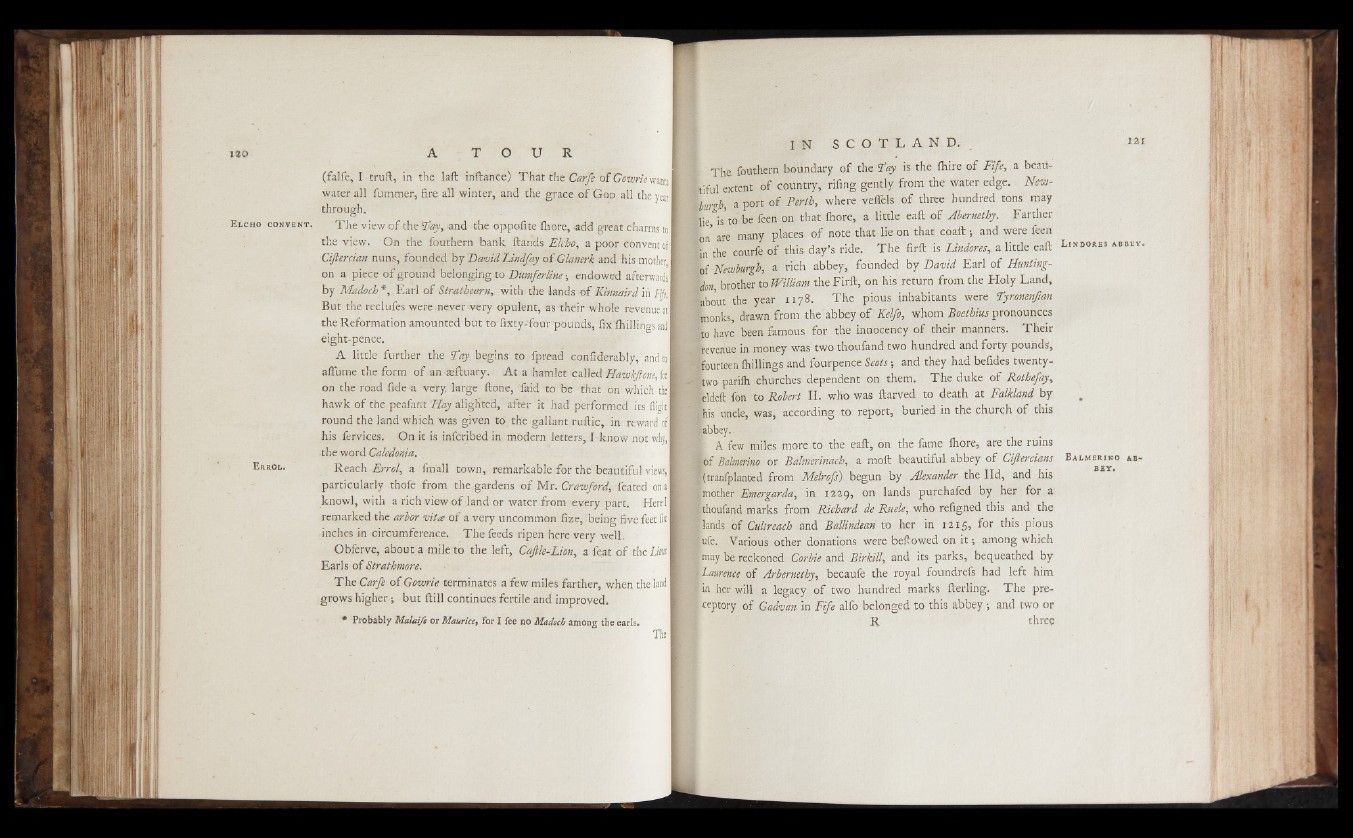
(falfe, I truft, in the laft inftance) That the Carfe of Gowriewants
water all futnmer, fire all winter, and the grace of G o d all the year
through.
E l cho c o n v e n t . The view of the Way, and the oppofite Ihore, add great charms to
the view. On the fouthern bank, ftands Elcho, a poor convent of
Ciftercian nuns, founded by DavidLindfay of Glanerk and his mother
on a piece of ground belonging to Dumferline; endowed afterwards
by Madoch*,. Earl of Strathearn„ with the lands of Kimaird in Fik
But the reclufes were never very opulent, as their whole revenue at
the Reformation amounted but to fixty-four pounds, fix Ihillings and
eight-pence.
A little further the fay begins to fpread confiderably, and to
afiume the form of an aeftuary. At a hamlet called Hawkjlone, fee
on the road fide a very, large ftone, faid to be that on which tte
hawk of the peafant Hay alighted, after it had performed its flight
round the land which was given to the gallant ruftic, in reward of
his fervices. On it is infcribed in modern letters, I know not wtff!
the word Caledonia.
E rrol. Reach Errol, a fmall town, remarkable for the beautiful views,
particularly thofe from the gardens of Mr. Crawford, feated on s
knowl, with a rich view of land or water from every part. Here!
remarked the arbor vita of a very uncommon fize, being five feet li*
inches in circumference. The feeds ripen here very well.
Obferve, about a mile to the left, Caftle-Lion, a feat of the Li0
Earls of Strathmore.
The Carfe of Gowrie terminates a few miles farther, when the land
grows higher; but ftill continues fertile and improved.
* Probably Malaife or Maurice, for I fee no Madoch among the earls.
n
j The fouthern boundary of the Way is the ihire of Fife, a beautiful
extent of country, rifing gently from the water edge. Newburgh,
a port of Perth, where veffels of three hundred tons may
lie is'to be feen on that ihore, a little eait of Abernethy. Farther
[on are many places of note that lie on that coaft ; and were feen
In the courfe of this day’s ride. The firft is Lindores, a little eaft
L Newburgh, a rich abbey, founded by David Earl of Huntingdon,
brother to William the Firft, on his return from the Holy Land,
[about the year 1178. The pious inhabitants were Tyronenfian
tmonks, drawn from the abbey of Kelfo, whom Boethius pronounces
¡to have been famous for the innocency of their manners. Their
¡revenue in money was two thoufand two hundred and forty pounds,
¡fourteen Ihillings and fourpence Scots; and they had befides twentytwo
pariih churches dependent on them. The duke of Rothefay,
leldeft fon to Robert II. who was ftarved to death at Falkland by
Ihis uncle, was, according to report, buried in the church of this
| abbey..
I A few miles more to the eaft, on the fame ihore, are the ruins
¡of Balmerino or Balmerinach, a moil beautiful abbey of Ciftercians
¡(tranfplanted from Melrofs') begun by Alexander the lid, and his
¡mother Emergarda, in 1229, on lands purchafed by her for a
Ithoufand marks from Richard de Ruele, who refigned this and the
¡lands of Cultreach and Ballindean to her in 1215, for this pious
lufe. Various other donations were beftowed on i t ; among which
[may be reckoned Corbie and Birkill, and its parks, bequeathed by
| Laurence of Arbernethy, becaufe the royal foundrefs had left him
I in her will a legacy of two hundred marks fterling. The pre-
[ ceptory of Gadvan in Fife alfo belonged to this abbey; and two or
R three
L in d o r e s a b b e y .
B a lm e r in o a b b
e y .